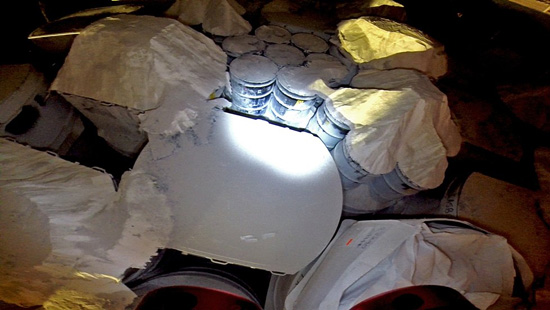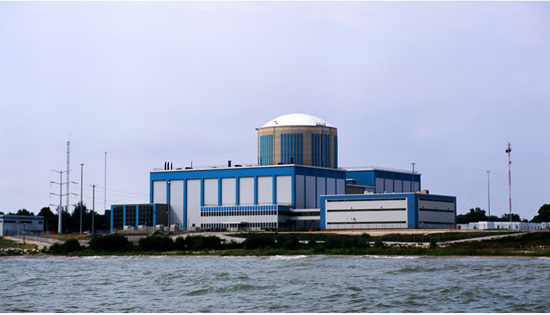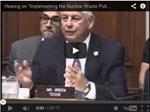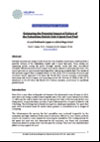Archive for the ‘News’ Category
Texas nuclear site increases monitoring of containers similar to 1 that leaked at federal site

FILE – This May 10, 2014 file photo provided by the Waste Isolation Pilot Plant shows torn and open bags of magnesium oxide on top of standard waste boxes at the WIPP site in Carlsbad, N.M. Workers at a West Texas nuclear waste disposal site are closely monitoring containers from Los Alamos National Lab, Tuesday, May 20, 2014, a day after New Mexico officials announced a type of kitty litter is believed to have caused a radiation leak at the federal government’s troubled nuclear waste dump. (AP Photo/Waste Isolation Pilot Plant, File)
MAY 20, 2014
By Betsy Blaney
Associated Press
LUBBOCK, Texas — Workers at a West Texas nuclear waste disposal site on Tuesday were closely monitoring containers being stored there temporarily, a day after New Mexico officials said drums packed with low-level waste and organic kitty litter may pose a potentially "substantial" threat to public health.
One container that used the organic litter is believed to have caused a radiation leak at the federal government’s troubled nuclear waste dump near Carlsbad, New Mexico.
Waste Control Specialists spokesman Chuck McDonald says the drums from Los Alamos National Lab are being monitored by video camera 24 hours a day as they sit inside a metal building on the company’s site. The New Mexico Environment Department said Tuesday that more than 100 containers at the Andrews County site in West Texas.
"If there is anything that is off normal we would be know about it immediately," McDonald said.
The containers came to WCS after a leak at the Waste Isolation Pilot Plant, the nation’s only permanent underground repository for low-level radioactive waste, contaminated 22 workers with low levels of radiation in February. New Mexico environmental officials said more than 350 containers are underground at the Carlsbad site.
The kitty litter soaks up any liquid before drums of waste are sealed and shipped. Officials are investigating whether a switch from non-organic to organic litter is to blame for the leak.
Texas Commission on Environmental Quality spokesman Terry Clawson said none of the containers show any signs of leaking and that every precaution was being taken to ensure safety at the WCS site.
On Monday, environmental officials in New Mexico issued a formal order giving the Los Alamos lab two days to submit a plan for securing the waste containers, many of which are likely stored outdoors on the lab’s northern New Mexico campus or at WCS.
The order says 57 barrels of waste that are at Los Alamos were packed with nitrate salts and organic kitty litter, a combination thought to have caused a heat reaction and radiation release.
No shipments are now coming to West Texas from Los Alamos, Clawson said.
This document contains copyrighted material whose use has not been specifically authorized by the copyright owner. SEED Coalition is making this article available in our efforts to advance understanding of ecological sustainability, human rights, economic democracy and social justice issues. We believe that this constitutes a "fair use" of the copyrighted material as provided for in section 107 of the US Copyright Law. If you wish to use this copyrighted material for purposes of your own that go beyond "fair use", you must obtain permission from the copyright owner.
LANL report admits errors in packing waste
July 3, 2014
By Staci Matlock
Santa Fe The New Mexican
Los Alamos National Laboratory has admitted mistakes were made in processing waste containers, including one that ruptured in the nuclear waste storage facility near Carlsbad, causing a radiation leak that shut down the Waste Isolation Pilot Plant.
LANL filed a report Thursday with the state Environment Department that cited noncompliance issues — but stopped short of saying the errors caused the leak.
The lab’s manager, Los Alamos National Security LLC, and the Department of Energy investigated the waste processing after a container from LANL burst open Feb. 14 in Panel 7 of the deep salt caverns at WIPP. The lab said it had “"insufficient evidence" that mistakes in handling nitrate salt-bearing waste had caused the container to leak.
Greg Mello of the Los Alamos Study Group, however, said the lab and Department of Energy’s assertion that there was insufficient evidence to link mistakes to the leak was "false."
"They very much do relate to the radioactive release at WIPP," Mello said of the errors listed in the report. "They did pose a threat to human health and the environment, and they still do."
State Environment Department officials said in a statement that they are reviewing these initial violations and plan “to take appropriate actions" following an independent review of the incidents at WIPP and LANL.
Lab officials said in a statement, "As part of our ongoing internal investigation, we have identified shortcomings in the processing procedures that led to actions not covered by the Los Alamos National Laboratory Hazardous Waste Facility Permit. The focus is now on correcting these processes, in addition to ongoing recovery work."
Federal and state investigators narrowed down the leak at WIPP to several drums from LANL. Chemists have said a combination of nitrate salts in the waste, a pH neutralizer and a wheat-based kitty litter used as an absorbent material in the drum could have caused a chemical reaction that cracked open the lid of the container.
Investigators still haven’t confirmed that a bad chemical mix is what caused the leak.
The eight-page report filed by the lab and federal officials details how the waste was handled and repackaged at the lab. The report concludes that adding the pH neutralizer and the organic kitty litter violated the lab’s hazardous waste permit from the state.
The lab approved the use of the neutralizers and a switch from inorganic clay absorbents to the wheat-based kitty litter in 2013, according to documents.
The lab and the Energy Department also found the waste stream should have been re-evaluated when technicians realized there was corrosive liquid in the drums that could react with other chemicals.
The lab has stopped processing the nitrate salt-bearing drums while officials continue to investigate. A total of 86 of the drums are stored in domes at the lab’s Area G waste facility. Of those, 57 have been treated with the neutralizer and the organic kitty litter, giving them the same potential for a chemical reaction. The other 29 containers haven’t been processed yet. The lab has created a remediation team to decide how to proceed with handling the waste.
Lab officials told the state Environment Department on June 3 that they were investigating possible irregularities in how radioactive waste containers with nitrate salts were processed at the lab’s facility.
The company contracted to repackage the waste, Salt Lake City-based EnergySolutions, has had three rounds of layoffs, totaling 83 people, since March 30. Company officials said the first round was due to completion of the waste repackaging project, and the firm was cutting back on personnel at the lab. The company said subsequent layoffs, the latest of which occurred Monday, were because Los Alamos National Security had to shift $20 million of the contract funds to cover costs of storing containers at a Texas facility and to help with the leak investigation at WIPP.
On the Web
• Read the LANL report at www.nmenv.state.nm.us/NMED/Issues/documents/LANLNoncomplianceNotice7-01-14.pdf
Contact Staci Matlock at 986-3055 or smatlock@sfnewmexican.com. Follow her on Twitter @stacimatlock.
WIPP radiation leak leads to layoffs at LANL
July 2, 2014
By Staci Matlock
Santa Fe The New Mexican
The Feb. 14 radiation leak at the Waste Isolation Pilot Plant near Carlsbad has sparked layoffs by a Los Alamos National Laboratory contractor.
EnergySolutions, the private company hired to pack mixed radioactive waste for shipment from Los Alamos to Carlsbad, laid off 40 employees Monday, for a total of 83 layoffs since the end of March.
Of the 40 employees laid off Monday, 28 were local people and four had relocated to Northern New Mexico for the lab waste project. EnergySolutions spokesman Mark Walker wasn’t sure how many of the other people laid off earlier were local.
Lab officials said the layoff coincided with the June 30 expiration of the lab’s subcontract with EnergySolutions.
But a company spokesman said some of the layoffs were made because LANL needed to shift funding to pay for storage of waste containers at a Texas facility after the radiation leak closed WIPP and to pay for part of the ongoing investigation into the leak.
EnergySolutions, based in Salt Lake City, was hired to repackage and ship out 3,706 cubic meters of transuranic waste by June 30. Transuranic waste consists of contaminated laboratory equipment and clothing, along with some liquids, used during nuclear research over the last several decades.
All of the transuranic waste had been packaged and ready to ship by the end of March, according to Walker. A total of 34 EnergySolutions employees were laid off then to “meet LANL requirements,” according to a letter from company Vice President Miles Smith.
Then in February, a LANL waste container that had been packed by EnergySolutions cracked open at WIPP, releasing radiation into the underground facility. All transuranic waste shipments from the lab were halted.
EnergySolutions laid off 23 more employees June 2 and were scheduled to lay off 58 on June 30.
“This is being driven by the fact that $20M of LANL’s 2014 Environmental Management funding has been reallocated to pay for the WIPP incident Technical Assistance Team made up of national laboratory personnel from across DOE and for continued storage of 113 containers of waste at Waste Control Specialists [in Andrews, Texas],” Smith said in a letter to the Regional Coalition of LANL Communities.
Of the 58 employees scheduled for layoffs Monday, 14 were reassigned to jobs elsewhere in the company. EnergySolutions kept 18 on for other contracted waste projects at LANL. EnergySolutions will work as a subcontractor for Albuquerque-based Environmental Dimensions Inc., which has a five-year federal contract that began July 1 for radioactive waste retrieval and packaging at the lab, according to Walker.
Greg Mello of the Los Alamos Study Group, a watchdog group, said LANL and the Department of Energy had other funds it could have tapped instead of using contract money for EnergySolutions. “It looks like Energy Solutions is being made to pay heavily for a mistake that was — at the very least — not entirely its own. Los Alamos National Security is the one ultimately to blame here.”
Contact Staci Matlock at 986-3055 or smatlock(at)sfnewmexican.com. Follow her on Twitter @stacimatlock.
This document contains copyrighted material whose use has not been specifically authorized by the copyright owner. SEED Coalition is making this article available in our efforts to advance understanding of ecological sustainability, human rights, economic democracy and social justice issues. We believe that this constitutes a "fair use" of the copyrighted material as provided for in section 107 of the US Copyright Law. If you wish to use this copyrighted material for purposes of your own that go beyond "fair use", you must obtain permission from the copyright owner.
Radiation leak leads to layoffs at Los Alamos
07/03/2014
Associated Press
LOS ALAMOS – The Los Alamos contractor that packaged the radioactive waste linked to a leak at the government’s nuclear waste dump is laying off workers.
A Los Alamos spokesman Wednesday confirmed that Energy Solutions has reduced its workforce by 115 because its contract for packing the waste for shipment to the Waste Isolation Pilot Project in Carlsbad expired June 30. That is the date the lab was supposed to have thousands of barrels of contaminated waste off its northern New Mexico campus. But the final shipments were halted after the February leak that shuttered WIPP was traced to a barrel packed by Energy Solutions.
Scientists think a reaction in the waste was fueled by the inorganic cat litter that was packed in the barrel to absorb moisture. Investigators are looking at the process followed by Los Alamos and the contractor in switching from inorganic to organic litter.
Copyright 2014 The Associated Press.
This document contains copyrighted material whose use has not been specifically authorized by the copyright owner. SEED Coalition is making this article available in our efforts to advance understanding of ecological sustainability, human rights, economic democracy and social justice issues. We believe that this constitutes a "fair use" of the copyrighted material as provided for in section 107 of the US Copyright Law. If you wish to use this copyrighted material for purposes of your own that go beyond "fair use", you must obtain permission from the copyright owner.
Wisconsin Reactor’s Demise Shows Nuclear Towns’ Plight
Jul 8, 2014
By Tim Jones
Bloomberg News

The Kewaunee Power Station, Wisconsin
Photographer: AP Photo
The best jobs and the biggest employer are disappearing from the town of Carlton, Wisconsin, leaving behind a site that should be ready for a new employer to move in, perhaps a half-century from now.
That’s the legacy of the 2013 shutdown of the Kewaunee Power Station, which generated nuclear energy for 39 years along the shoreline of Lake Michigan. The plant is being dismantled, or decommissioned, a potentially decades-long clean-up that could remove as much as 900 acres from the economic development base of rural Kewaunee County.
"Probably 60 years for sure," said David Hardtke, the chairman of the town of about 1,000. "All I know is I won’t be around. I guess my kids will have to fight that one out."
The Wisconsin facility is part of what Moody’s Investors Service describes as the largest wave of U.S.-based nuclear and coal electric-plant retirements in the past 35 years. The closings stem from abundant supplies of cheaper natural gas and changes in environmental policies. The consequences can be sudden and drastic, affecting school funding, real-estate values and economic development that were linked to the facilities.
Unlike abandoned industrial plants, which can be retooled for another manufacturer, nuclear plants leave another legacy: radioactive waste, which at the Kewaunee site sits in concrete canisters about 100 yards (91 meters) from Lake Michigan.
"The challenge that local officials have to face is large," said Julie Beglin, one of the report’s co-authors.
Economic Power
Sixty-four nuclear plant sites are spread across the country, with 100 operating reactors, according to the Nuclear Energy Institute. About half those reactors are comparable in age to the Kewaunee facility, having been built between 1968 and 1979. The plentiful supply of less-expensive energy, such as natural gas, increases the risk to local governments that are financially reliant on the plants, Moody’s said.
"These places are located in largely rural communities and so they are often the biggest taxpayer in the locality," said Daniel Lipman, executive director of the Nuclear Energy Institute, the Washington-based nonprofit advocate for the nuclear power industry.
Hot Gas
Dominion Resources Inc. (D), a Richmond, Virginia-based power company, closed the 556-megawatt Wisconsin plant in May 2013, citing economics that worked against it.
"It was cheaper to purchase energy on the open market than to produce it at Kewaunee," said Mark Kanz, a company spokesman. "I’m sure it won’t be the last to close. There will be other plants that go through decommissioning, whether it’s economics or from equipment-related issues."
Moody’s said natural-gas supplies are influencing decisions to "retrofit or extend the life" of plants. While the economics of power generation can change, two factors work against the nuclear industry, said David Lochbaum, director of the Nuclear Safety Project at the Union of Concerned Scientists.
"The cost of non-nuclear electricity is trending down," Lochbaum said, "and the cost of maintaining aging nuclear power reactors is trending up."
The Vermont Yankee nuclear power station, in the southeast Vermont community of Vernon, is to close by year-end. Moody’s said the town of 2,200 receives 48 percent its operating revenue from operation of the plant, which is owned by Entergy Corp. (ENT)
Six Decades
The aftermath of a nuclear power plant’s leaving a community is more complicated and lengthy than the end of a conventional industrial facility. Federal regulations governing the decommissioning of sites are designed to protect the public.
The process must be completed within 60 years, according to the Nuclear Regulatory Commission. Seventeen plants, including Kewaunee, are in some phase of decommissioning, the NRC said on its website.
The Wisconsin facility was the largest employer in Kewaunee County, a rural expanse east of Green Bay, where dairy cows outnumber the 21,000 people by a ratio of more than 2-to-1. About 630 people worked at the plant before it closed last year. Now, about 260 work on mothballing it. By October, only 140 will.
"They were the highest-paying jobs in the county, and a big chunk of that was flowing through the economy," said Ron Heuer, chairman of the county board of commissioners. "What the hell do we do now?"
Linda Sinkula, Carlton’s clerk and also a county supervisor, said the town will have little choice but to raise taxes.
"It’s just a mess," she said.
Empty Booths
Carlton will lose about $360,000 in annual revenue, roughly 70 percent of its $515,000 budget, said Hardtke, the town chairman. The county will lose about $730,000 a year, Heuer said.
At the street level, Kunkel’s Korner, a diner in downtown Kewaunee, about 5 miles north of the plant, is less busy.
"People we used to see three times a week we now see only once a week," said owner Mark Kunkel. "We’d average 100 to 125 a day. Now it’s down to 80 to 85."
There’s a glut of homes for sale, with a 25 percent to 30 percent increase in houses on the market, said real-estate agent Jack Novak.
Yet to be determined is the taxable value of the Kewaunee plant site and how much revenue Carlton and the county could anticipate. Hardtke said an appraiser is evaluating the land and that his report should be submitted in weeks.
Fallow Ground
The experience of Zion, Illinois, a Lake Michigan community of 24,000 about halfway between Chicago and Milwaukee, suggests the value will be a fraction of the taxes generated when that town’s nuclear power plant was operating.
The Zion nuclear power station, built in 1973, closed in 1998 after an equipment failure led to a yearlong shutdown. At its peak in 1996, the plant on about 200 acres paid the town $19.6 million, according to Finance Director David Knabel. That was roughly half the tax base, he said.
More than 16 years later, the plant is still being dismantled. The cooling towers remain, and nuclear waste is stored in a bunker. Taxes collected on the site amounted to only $1.5 million in 2012, Knabel said.
"There’s 200 acres of lakefront property that is completely undevelopable, unusable until they are done decommissioning the site," Knabel said.
"I’d love to be able to put condos and restaurants there, but they’d be overlooking a bunker filled with nuclear waste," Knabel said.
In the meantime, Scott Bortolini, who chairs the Kewaunee County Economic Development Corp., said the search is on for new jobs. Dairy cows represent 25 percent of the county’s economy, "but they don’t pay a lot of taxes," he said.
(A previous version of this story spelled Daniel Lipman’s name incorrectly.)
To contact the reporter on this story: Tim Jones in Chicago at tjones58(at)bloomberg.net
To contact the editors responsible for this story: Stephen Merelman at smerelman(at)bloomberg.net
This document contains copyrighted material whose use has not been specifically authorized by the copyright owner. SEED Coalition is making this article available in our efforts to advance understanding of ecological sustainability, human rights, economic democracy and social justice issues. We believe that this constitutes a "fair use" of the copyrighted material as provided for in section 107 of the US Copyright Law. If you wish to use this copyrighted material for purposes of your own that go beyond "fair use", you must obtain permission from the copyright owner.


